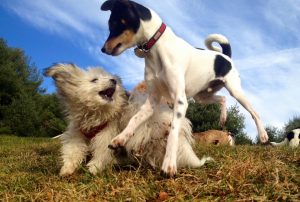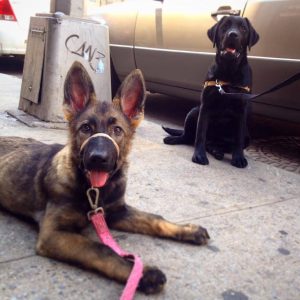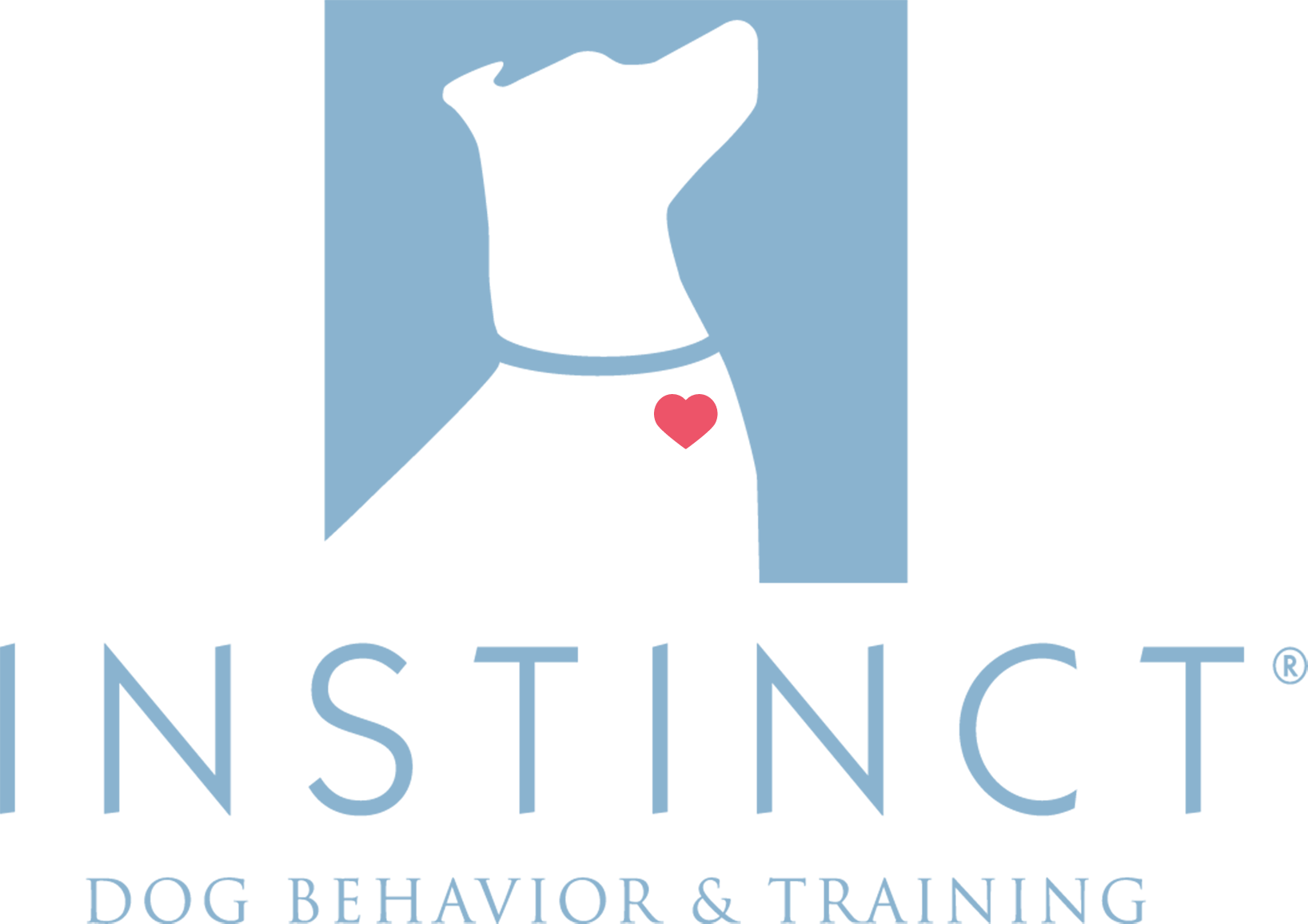For many new dog owners, dog daycare conjures images of fluffy friends romping and playing, maybe stopping for a mid-afternoon snooze in a quiet sun spot, and returning home at the end of the day tired and happy.
And while dog daycare can offer physical exercise, mental stimulation, and companionship to some dogs during otherwise long and lonely work days, it’s important for dog owners to know that a) not all daycares are created equal; b) not all dogs will enjoy daycare (and this is normal); and c) there are lots of fantastic non-daycare options that can provide dogs with exercise, mental stimulation, and companionship.
Understanding Normal Dog Social Behavior
When we’re considering daycare as a potential care option for our dogs, it’s important that we also understand what is considered normal social behavior for a dog.
Young Dogs are More Socially Adventurous
Typically, puppies and young dogs are more outgoing and social, ready to make friends and engage in play with almost every dog they meet. Young dogs often thrive in an appropriate, well-run daycare setting, as they have the energy level and motivation to play for extended periods of time. This youthful enthusiasm does come with a flip side though: younger dogs don’t always self-manage and fail to give themselves the breaks they need during long bouts of play, and so often benefit from helpful humans stepping in to encourage pauses and downtime. Be sure to look for a daycare that is structured to give dogs breaks and quiet times throughout the day, so they can receive much-needed mental breaks in addition to social time.
Growing Up: Trading Clubs for Pubs
Just like humans, our dogs mature. And with maturity comes a shift in social preferences (like trading in your favorite college nightclub for a low-key pub!). Most dogs are going to transition away from the “All-Play-All-the-Time-with-All-the-Dogs!!” puppy mindset and fall somewhere in the ‘socially selective’ range as adults. This means our adult dogs might still like to greet many dogs and will enjoy playing with some, but often don’t enjoy active play with lots of dogs at once, or for extended periods of time. An adult dog who wants to play with every dog is actually outside of the range of normal adult social behavior, as is a dog who behaves aggressively to all other dogs.
My experience from running my own dog daycare in Canada for many years is that dogs who attend since puppyhood will, at some point (usually between 2-4 years of age), stop enjoying daycare. As daycare owners, this was always hard for us; we enjoyed seeing these familiar dog faces over months and years and developed strong relationships with them as friends and caregivers. But, it was usually pretty clear when a dog stopped having fun, and it was our job to ensure they weren’t being put in a situation that caused them stress or unhappiness.
Signs Daycare Isn’t the Right Fit Anymore
If your dog currently attends daycare, it’s a great idea to check in regularly with the daycare manager or owner about any changes in your dog’s behavior. Questions to ask include:
- Is my dog playing less often than they used to?
- Does my dog ask to leave the play room more frequently, or spend more time by the exit?
- Does my dog seem less tolerant of other dogs, quicker to snap or get into altercations?
- Does my dog seem more stressed or uncomfortable as the day goes on?
If your daycare provider notices any of these signs in your dog, you can work with them to try switching your dog to quieter, less frequent or shorter days if possible.
Sometimes though, these adjustments aren’t enough, and it is in the dog’s best interest to find an alternate activity that is less stressful, and more enjoyable for them.
Alternate Dog-Socialization Activities

We recently conducted a survey of dog daycare users. When asked about their primary reasons for sending their dog to daycare, most owners told us daycare was a way to give their dog opportunities to socialize with other dogs. If your dog can no longer attend daycare, there are other social activities available!
Dog-Friendly?
If your dog likes to play with many other dogs, but just isn’t a happy camper at daycare for whatever reason, there are lots of other options for dog-dog interaction:
- Dog Runs: Dog runs should be used sparingly, as a busy dog run may too similar to a daycare for your pup. Going to the dog run at quieter times, and for short bouts (no more than 45 minutes) works best for most dog-friendly dogs.
- Parks: Visiting dog-friendly hiking trails or public parks with designated off-leash hours can be a very enjoyable social activity for your dog. Bigger, more open spaces make it easier for your dog to avoid or move away from other dogs, which removes a lot of pressure in social interactions and sets your dog up for success.
- Play Dates: One-on-one play is always our preferred way for dogs to play, and most dogs seem to prefer it too! Meeting up with a friend and their friendly dog for a doggy play date in your backyard or in another safe, dog-friendly spot is a great, low-stress socialization option.
- Group Walks: Some dogs really enjoy going on group walks with other dogs. You can do this yourself by coordinating and meeting up with several dog owners, or you can send your dog with a qualified pair of dog walkers who work together to take dogs out for walks in small groups.
Dog Selective?
The majority of our survey responders described their dog as ‘dog selective’ – the dog enjoys meeting and playing with some dogs, but not ‘many’ or ‘all’ dogs. Most dogs with this type of social preference may not enjoy daycare, especially on busy days, but they have other options:
- Parks: Dog selective dogs will generally have a more pleasant time in a social setting that allows them space to move away and avoid interacting. Large parks that allow dogs off-leash can be a great spot for this, especially if you have the ability to take your dog to a quieter, less concentrated area with few dogs to allow for some fun off-leash exploring.
- Long Line Walks: Long line ‘sniffer’ walks are great for dogs who aren’t reliable off leash, or when off leash hours aren’t available. While this isn’t actually a dog socialization activity, don’t underestimate its value – exploring and sniffing is wonderful a mental enrichment and can really tire out your pooch.
- Play Dates: Dogs in this category often enjoy time spent with a few good dog friends in a back yard, at the park, hiking, or at the beach.
- Dog Walker: A paired or small group dog walker can also be a great option for dog selective dogs, as they get to engage in a parallel activity (walking together), but aren’t being asked to deal with rambunctious wrestling or interacting with a large number of strange dogs.
Fearful or Aggressive?
Not every dog loves being around other dogs (and that’s okay). Some dogs will forever prefer to engage in only non-dog-focused activities, of which there are many. But many dogs who display fearful or aggressive behaviors around other dogs can still enjoy spending time around a small group of carefully selected canine friends after a gradual introduction process. (Note: If your dog has seriously injured another dog, always consult with a professional trainer for guidance before attempting to introduce your dog to new dogs)
- Dog Run: The dog run is not recommended for dogs who display fearful or aggressive behavior toward other dogs.
- Park: Dogs who are fearful of other dogs will often enjoy long line sniffer walks in quieter areas of public parks. If your dog has a history of being aggressive towards other dogs, avoid areas of public parks where another dog may run up to you unexpectedly, always use a long line, and condition your dog to comfortably wear a basket muzzle.
- Paired Walks or Private Walks: Depending your dog’s level of fearful or aggressive behavior, a paired or private walk with a skilled dog walker can be a great way to provide exercise and let your dog get out and see the world!
- Day Training: Day training – where a trainer visits your home during your work day to train your dog – is a great option to break up your dog’s day, give them some enrichment, mental exercise, and improve their manners too!
If you feel your dog fits into this category, we recommend finding a great positive reinforcement-based trainer skilled in dog-dog socialization. While it’s generally not possible to take a dog from dog aggressive to entirely dog social, a trainer can work with you to help your feel more comfortable and make better choices in the presence of other dogs.
Alternate Activities to Reduce Time Spent Home Alone

If you previously used dog daycare so you dog wouldn’t be home alone all day, or just wanted them to burn off some energy, suitable alternative options can include:
- Pet Sitter: Some people offer an all-day pet sitting service at your home or theirs. This is a great alternative to daycare for a dog who cannot stay home alone. You may be able to find a friend who works from home or works a different schedule than you, who would love to have a canine companion part-time as well.
- Hiking Service: These services often offer pick-up and drop-off, and can work well for dogs who need to be supervised during the day, but can’t attend daycare.
- Day Training: Typically, Day Training programs involve a trainer visiting your home during your work day to train your dog. Alternately, programs may be structured where the dog goes to a training facility during the day to work on obedience or behavior modification but not necessarily socialize with other dogs. Again, this is a great option for a dog that can’t stay home alone.
Finding a Great Pet Care Provider
When researching a daycare, pet sitter, dog walker or trainer, it’s important to remember that there are a variety of different styles and types. For example, some daycares may be large, but still well run. Some may be smaller, and some may focus more on individual enrichment (training, walks etc.) than large play groups.
Regardless of variation there are some common qualities to consider while hunting for a good place for your pooch.
First, you should get a general welcoming, caring feeling from the staff. The facility (if there is one) should look and smell clean – expect a ‘doggy’ smell but it should not be overpowering and should not smell strongly of urine or feces.
Second, play and walking groups should generally be split by size of the dogs. For safety, small dogs (under 35lbs) should not be in a mixed group with large dogs. More important than the total number of dogs is the ratio of staff to dogs. In a daycare, you want to see ideally one handler per 15 dogs. Too many dogs per dog walker is also potentially unsafe. A large group of dogs with not enough staff to supervise is at a much higher risk for incidents.
Third, it’s a great sign if the care provider wants to take time to get to know your dog. They should ask questions about your dog’s behavior and history, and likely will want to do a shorter initial visit to evaluate behavior and get your dog acclimated to their environment.
Final Verdict
Overall, daycare in moderation can be a great, fulfilling activity for many dogs. Just be aware that it is not for every dog, and your dog may not enjoy it forever. Relying on daycare as your main source of exercise and stimulation for your dog is not recommended. Stick to no more than three days per week, and make sure you allot time to walk, train and play with your dog as well. Getting to spend time around other dogs is important for some dogs, but more than anything, dogs want to spend time doing mutually enjoyably activities with their people.



